Determining the rehabilitation success of the old tailings storage facility of Navachab Gold Mine, Karibib, Namibia

|
Authors: Rentel, U; Rentel, M Paper is not available for download Contact Us |
DOI https://doi.org/10.36487/ACG_repo/908_6
Cite As:
Rentel, U & Rentel, M 2009, 'Determining the rehabilitation success of the old tailings storage facility of Navachab Gold Mine, Karibib, Namibia', in AB Fourie & M Tibbett (eds), Mine Closure 2009: Proceedings of the Fourth International Conference on Mine Closure, Australian Centre for Geomechanics, Perth, pp. 109-121, https://doi.org/10.36487/ACG_repo/908_6
Abstract:
Biodiversity and ecosystems are negatively affected by mining. Restoration is an important practice that can facilitate the rehabilitation of an area when mining has ceased. This ensures that the ecosystem is restored to the best capability as before transformation. The purpose of the study was to determine whether rehabilitation on an old tailing storage facility (TSF), Navachab Gold Mine, Karibib, Namibia, was successful. This is important as it will provide an indication if more rehabilitation is still required. Four different sites: one year (rehabilitated 2007); three years (rehabilitated 2005); five years (rehabilitated 2003); and an undisturbed reference site were selected on the old TSF. Twelve 5 × 5 m quadrants (three on each of the four sites) were randomly distributed on the different sites. On these sites all fauna and flora species were recorded using various techniques during December 2008 and January 2009. The results show that a great diversity of plants, insects and larger mammals can be found on the old TSF, indicating a stable environment. Unfortunately, many species only occur on one of the sites and not on all sites, especially in terms of plants and insects. It is thus recommended that rehabilitation should continue and that more plant species should be planted to increase the presence of endemic species on the old TSF.
References:
Andersen, A.N., Fisher, F., Hoffmann, B.D., Read, J.L. and Richards, R. (2004) Use of terrestrial invertebrates for
biodiversity monitoring in Australian rangelands, with particular reference to ants, Austral Ecology, 29(1),
pp. 87–92.
Arrington, D.A. and Winemiller, K.O. (2006) Habitat affinity, the seasonal flood pulse, and community assembly in the
littoral zone of a Neotropical floodplain river; Journal of the North American Benthological Society, 25(1),
pp. 126–141.
Bever, J.D. (2003) Soil community feedback and the coexistence of competitors: conceptual frameworks and empirical
tests, New Phytologist (2003) 157 New Phytologist Trust, Blackwell Publishing, pp. 465–473.
Chao, A. and Shen, T-J. (2003) Nonparametric estimation of Shannon’s index of diversity when there are unseen
species in sample, Environmental and Ecological Statistics, 10, Springer, Netherlands, pp. 429–443.
Mine site rehabilitation in a changing climate
Mine Closure 2009, Perth, Australia 121
Department of Water and Forestry (DWAF) (2001) South Africa, Working for water’s main objectives, Northern
Province Newsletter.
Ghebremariam, G.E. (2004) Monitoring the success of an old-field rehabilitation trial in the winter rainfall succulent
Karoo: the effect of Oxalis pes-caprae, Master’s Thesis, University of Stellenbosch, p. 2.
Henderson, P.A. (2006) Practical Methods in Ecology, Blackwell Publishing, p. 121.
Ludwig, A.L., Hindley, N. and Barnett, G. (2003) Indicators for monitoring rehabilitation: trends on waste-rock dumps,
northern Australia, Ecological Indicators, 3, Elsevier, p. 1.
Marschner, P., Yang, C-H., Lieberei, R. and Crowley, D.E. (2001) Soil and plant specific effects on bacterial
community composition in the rhizosphere, Soil Biology and Biochemistry, 33, p. 1.
McKillup, S. (2006) Statistics Explained, An Introductory Guide for Life Scientists, Cambridge University Press,
pp. 152–155 and pp. 232–235.
Muylaert, K., Sabbeb, K. and Vyverman, W. (2009) Changes in phytoplankton diversity and community composition
along the salinity gradient of the Schelde estuary (Belgium/The Netherlands), Estuarine, Coastal and Shelf
Science, 82, 2, Elsevier, pp. 335–340.
Navachab Gold Mine (1997) Initial Environmental Review Report EMS MANUAL (Volume 1) April 1997, Envirolink
pp. 14–26.
Navachab Survey Department (2006) Satelite Image of TSF.
Schmidt, A. (2002) Strip-mine rehabilitation in Namaqualand, Master’s Thesis, University of Stellenbosch.
Schowalter, T.D. (2006) Insect ecology, An Ecosystem Approach, Second Edition, Academic Print, Elsevier, 572 p.
Timberline Forest Inventory Consultants Ltd (2003) Monitoring plant diversity: Simpson’s index and species richness
assessment, Prepared for the Canadian Forest Products Ltd, March 2003.
Steffan-Dewenter, I. and Tscharntke, T. (2002) Insect communities and biotic interactions on fragmented calcareous
grasslands-a mini review, Biological Conservation, 104, pp. 275–284.
Urdan, T.C. (2005) Staistics in plain English, 2nd Edition, Psychology Press, Taylor and Francis Group, New York,
USA, p. 86.
Venter, D.B. (2005) An ecological approach to the reclamation and improvement of arid rangelands using adapted
fodder plants, Master’s Project Proposal University of Pretoria.
© Copyright 2025, Australian Centre for Geomechanics (ACG), The University of Western Australia. All rights reserved.
View copyright/legal information
Please direct any queries or error reports to repository-acg@uwa.edu.au
View copyright/legal information
Please direct any queries or error reports to repository-acg@uwa.edu.au